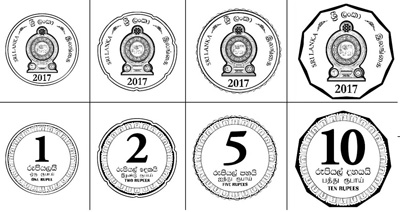New smaller coins into circulation
A new series of smaller circulation coins released by the Central Bank (CB) will be issued to the public, on December 3 after a presentation box was given to Prime Minister and Minister of Finance Mahinda Rajapaksa on November 27.
The Rs.10 and Rs. 5 coins have been made thinner and the Rs. 2 coin has been made 30 per cent smaller. Seven notches have been cut into the side of the Rs. 2 coin to make it more easily identified by the visually impaired people. The Rs. 2 coin diameter has been reduced from 28.3 mm to 22 mm, something that should have been done back in 2005 with the Rs. 1 coin, which reduced then from 25.4 mm to 20 mm. All are cost-cutting measures which are being marketed with the weight of coins is reduced to give more portability.
The basic design layout of these standard circulation coins has been changed significantly. For the first time since the circulation standard, the one Rupee coin was introduced in 1963 in the Sinhala only era, the name of the country appears on it in Tamil and English.
The design has on the obverse the Armorial Ensign of Sri Lanka with the short name of the country SRI LANKA in English, in Sinhala, and in Tamil, on left, top and right of ensign. The year 2017 is at the bottom, all within a plain circle inside a raised rim. On the reverse large numeric value on top with the value in Sinhala, Tamil, and English, in three lines below with decreasing font size – all within a border of traditional lotus petals around the periphery.
The last time the sizes of coins were changed in 2005 the CB did a lot of publicity about the fact to educate the public. This time there has been hardly any notice to the public. The CB press release has not even mentioned the new weights of coins as they always do when the circulation standard weight is changed. That was always part of the Gazette notices of the past at least since 1870. When I phoned and asked the CB for the weights, I was told it was not part of the specification given to the Kremnica mint. I hope banks and coin machines will handle the change.
Tender for these coins was called in July 2016 and orders placed in March 2017 for almost a billion coins from Mincovna Kremnica of the Slovak Republic. In 2013 they got the first order to mint only the Rs. 10 coins in AISI 430 Stainless Steel and now mints all Sri Lanka coins as they also did in 2016. This has now broken the tradition of minting coins at the Royal Mint in UK, which did so almost exclusively for over 50 years from 1959 to 2011.
By the time these coins have been issued, the Rs.1 and Rs. 2 hardly get circulated. Trishaws round upwards to Rs. 10 ignoring a Rs. 2 and buses to Rs. 5. Bus conductors never give a rupee in change and often ignore a rupee short, if you ask them instead to change a currency note.
Based on documents I found put online, posted by the Kremnica mint, the estimated cost of minting a coin and the millions of coins minted is given in the following Table.
Since coins have a long lifetime, it is curious why the number of 2017 coins ordered for 2017/18 is more than five times the increase in coins of the same denominations over the year from August 2017 for which CB data is published. The 2017 coins remained in the CB vault for over a year before being issued. The one and two rupee coins still cost more than face value to mint. So why mint them when they may never be used? The same happened with the 25 cent and 50 cent coins minted in 2009.
The CB seems to be stocking even currency notes much longer than the Finance Ministers and Governors of the Central Bank remain in office.
More than two years after he left, the CB is still releasing new Rs. 1000 notes with the signature of Arjuna Mahendran, and the only note issued so far with the signature of Mangala Samarweera, who was in office 1½ years ago, is a commemorative for the 70th anniversary of Independence.
These new coins are circulated along with the existing coins of the same denominations issued earlier. The coins will be issued into circulation through licensed commercial banks. I was told that small cellophane packs with Rs. 100 worth of coins will be sold to collectors from the CB Economic History Museum from Monday December 3 after 9 am.
The issue of these smaller coins, just after a month, where the rupee depreciated by almost 5 per cent, reflects the economic crisis we are in, and will probably be misinterpreted by the public.


